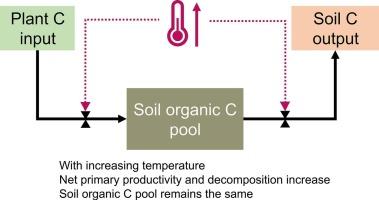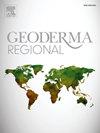温度升高会加速温带山地森林的碳循环,但不会降低土壤碳储量
IF 3.3
2区 农林科学
Q2 SOIL SCIENCE
引用次数: 0
摘要
预计全球变暖将加速土壤有机碳(SOC)的循环和新碳的同化,但这些反作用加速的净效应及其对 SOC 的最终影响仍不确定。这阻碍了对生物圈碳储量长期变化和 SOC-气候反馈的预测。在此,我们研究了温度对新西兰温带森林生态系统中3.2 °C高度温度梯度上碳循环的长期影响。在整个梯度上,土壤呼吸速率随着温度的升高而增加,从 9.0 吨碳/公顷-年增加到 10.4 吨碳/公顷-年,但 85 厘米深度以下的 SOC 储量也有增加的趋势,从 154 吨碳/公顷-年增加到 176 吨碳/公顷-年,尽管增加的幅度不大(P = 0.06)。该系统能够在较高温度下保持较高的土壤呼吸速率而不减少 SOC,因为较高的呼吸速率是由较高的落叶率维持的。沿温度梯度,地上落叶量从 1.8 吨碳/公顷-年增加到 2.4 吨碳/公顷-年,估计地下碳输入量从 7.2 吨碳/公顷-年增加到 8.0 吨碳/公顷-年。这些较高的通量与较高温度下生物量的显著增加有关(P < 0.05)。作为温度对碳循环过程影响的直接测量,我们还计算了森林枯落物的周转率,该周转率在温度梯度上增加了约 1.4 倍。这项研究表明,沿温度梯度较高的地区通过提高总初级生产量增加了植物碳输入,这抵消了通过温度提高土壤呼吸作用造成的 SOC 损失。这些结果表明,在预测 SOC-气候反馈时,必须考虑植物碳输入和 SOC 损失对温度的敏感性。本文章由计算机程序翻译,如有差异,请以英文原文为准。

Higher temperature accelerates carbon cycling in a temperate montane forest without decreasing soil carbon stocks
Global warming is expected to accelerate the cycling of soil organic carbon (SOC) and the assimilation of new carbon, but the net effect of those counteracting accelerations and their ultimate effects on SOC are still uncertain. This hinders the prediction of long-term changes in biospheric carbon stocks and SOC-climate feedbacks. Here, we studied the long-term effect of temperature on carbon cycling across a 3.2 °C altitudinal temperature gradient in a temperate forest ecosystem in New Zealand. Across the gradient, soil respiration rates increased with increasing temperature from 9.0 to 10.4 tC ha−1 yr−1, but SOC stocks down to 85 cm depth also tended to increase, from 154 to 176 tC ha−1, albeit non-significantly (P = 0.06). This system was able to maintain higher soil respiration rates at higher temperatures without reducing SOC because the higher respiration rates were sustained by higher litterfall rates. Aboveground litterfall increased from 1.8 to 2.4 tC ha−1 yr−1 and estimated belowground C inputs increased from 7.2 to 8.0 tC ha−1 yr−1 along the temperature gradient. These higher fluxes were associated with significantly (P < 0.05) increased biomass at higher temperatures. As a direct measure of the effect of temperature on carbon cycling processes, we also calculated the turnover rate of forest litter which increased about 1.4-fold across the temperature gradient. This study demonstrates that higher temperatures along the thermal gradient increased plant carbon inputs through enhanced gross primary production, which counteracted SOC losses through temperature-enhanced soil respiration. These results suggest that temperature sensitivities of both plant carbon inputs and SOC losses must be considered for predicting SOC-climate feedbacks.
求助全文
通过发布文献求助,成功后即可免费获取论文全文。
去求助
来源期刊

Geoderma Regional
Agricultural and Biological Sciences-Soil Science
CiteScore
6.10
自引率
7.30%
发文量
122
审稿时长
76 days
期刊介绍:
Global issues require studies and solutions on national and regional levels. Geoderma Regional focuses on studies that increase understanding and advance our scientific knowledge of soils in all regions of the world. The journal embraces every aspect of soil science and welcomes reviews of regional progress.
 求助内容:
求助内容: 应助结果提醒方式:
应助结果提醒方式:


